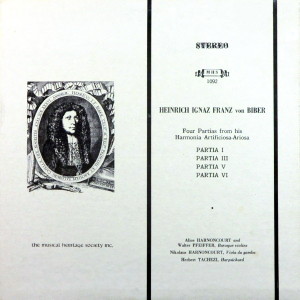 |
1 LP -
MHS 1092 - (p) 1965
|
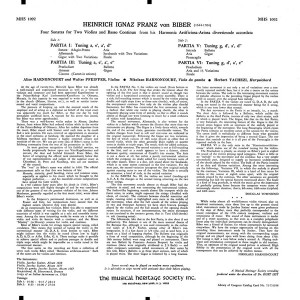 |
1 LP -
MHS 1092 - (p) 1965 (rectus)
|
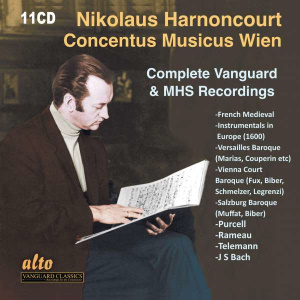 |
| 11 LP -
alto ALC 3145 - (p) & (c) 2022 |
|
| Heinrich Ignaz
Franz von Biber (1644-1704) |
|
|
|
|
|
|
|
| Four Sonatas for Two
Violins and Basso Continuo from his
Harmonia Artificiosa-Ariosa
diversimode accordata |
|
|
|
|
|
|
|
| Partia I: Tuning a, e',
a', d" |
|
14' 56" |
A1 |
| - (Sonata:
Adagio-Presto - Aria - Allemande -
Sarabande with Two Variations - Gigue
with Two Variations - Finale) |
|
|
|
| Partia III: Tuning a,
e', a', e" |
|
9' 17" |
A2 |
| - (Praeludium -
Balletto - Amenere - Gigue - Ciacona:
Canon in unison) |
|
|
|
| Partia V: Tuning g, d',
a', d" |
|
8' 35" |
B1 |
| - (Intrada - Balletto
- Aria - Gigue - Passacaglia) |
|
|
|
| Partia
VI: Tuning g, d', a', e"
|
|
19' 00" |
B2 |
| - (Praeludium - Aria
and 13 Variations - Finale) |
|
|
|
|
|
|
|
Alice
Harnoncourt, Violin
(Jacobus Stainer, Absam 1658)
|
|
Walter
Pfeiffer, Violin (Jacobus
Stainer. Absam 1677)
|
|
Nikolaus
Harnoncourt, Viola da gamba
(Jacobus Stainer, Absam 1677)
|
|
Herbert
Tachezi, Harpsichord (M.
Skowroneck, Bremen - copy of an
Italian instrument ca. 1700)
|
|
|
Luogo e data
di registrazione
|
| 1965 |
|
Registrazione
live / studio
|
| studio |
Producer / Engineer
|
Dr. Kurt List
|
Prima Edizione
CD
|
| alto
- ALC 3145 - (11 CD) - 51' 48" -
(p) & (c) 2022
|
Prima
Edizione LP
|
Musical Heritage Society - MHS
1092 - (1 lp) - 51' 48" - (p) 1965
|
| Note |
| Library of Congress Catalog
No. 72-751956 |
|
|
Notes
|
At the age of twenty-two,
Heinrich Ignaz Biber was already a
well-trained and experienced musician as
well as a virtuoso violinist and composer
and had been appointed Kapellmeister to
the Prince-Bishop Karl
Liechtenstein-Kastelkorn in Olmuetz,
Morazia. In this capacity he was required
to write works for use in the church
(Masses, litanies, etc.), as well as
secular instrumental and vocal
compositions.
The pressure of keeping up with the
musical needs of his employer and of
acting as a diplomat on behalf of the
royal court was apparently too much for
Biber, so that one day he took permanent
unofficial leave. A warrant for his arrest
was issued, but Biber was never
apprehended.
There was a well-known violin maker in
Absam, Jacobus Stainer, from whom Biber
had ordered violins while in the service
of the Prince-Bishop of Oelmuetz. After
his sudden departure from the court, Biber
stayed with Stainer until such time as he
could find a new position. He soon
received an appointment as musician in the
court orchestra at Salzburg. He married
the daughter of a Salzburg merchant and
became a highly esteemed citizen and
musician of the city. We can get some idea
of Biber's status in the Salzburg
community from the text of his
promotion in 1679:
"In most gracious recognition of his
faithful services, we hareby
propitiously bestow upon our
Vice-Kapellmeister and servant, the dear
and faithful Heinrich Franz Biber, the
honor of occupying the official rank
immediately below that of our
superintendents and judges of the
superior court in Chiembsee, St. Peter
and Numberg, who are not members of the
council."
The "von" in Biber's name was added in
1690. The official announcement tells us
that this was because of his:
"Honesty, sincerity, good breeding,
virtue and common sense, especially as
applies to his music which he brought to
the highest perfection... and his
manifold artistic compositions have
spread his fame widely."
In 1740 (alomost forty years after his
death in 1704), Biber's compositions were
still highly thought of and he was
considered one of the greatest if not the
greatest violinist of his time. Johann
Mattheson, generally regarded as the first
music critic, wrote about Biberýs works:
"In the Emperor's patrimonial
dominios, as well as in France and
Italy, his compositions have earned him
the highest esteem wherever they were
played."
As an exceptionally fine violinist, Biber
was able to experiment with different
types of writing for the violin, and the
different sonorities of which it was
capable as a solo and ensemble instrument.
Among the more interesting works he wrote
are a duet for violin and viola da braccio
with a continuo, and the fifteen "Mystery"
(or Rosary) sonatas for violin and
continuo.
Most of Biber's works for strings require
special tuning, calied scordatura.
This means that instead of tuning the
violin in the conventinal manner (G, D, A,
E, from bottom to up), Biber might
indicate that the violin be tuned (from
low to high) A, D, A, D, or A-flat,
E-flat, G, A, These tunings make it
possible to acheeved special effects and
to perform passages in double and triple
stops which might be impossible on a
violin tuned in the conventional manner.
The four suites on this recording are from
a collection of seven such works Biber
called "Harmonia artificiosa-ariosa". Each
of the suites are for violin and continuo.
In the PARTIA No. I, the violins
are tuned (from bottom to top) A, E, A, D.
The first thing that strikes the listener
about the opening of the first suite is
that it doesn't sound as though two
violins and a harpsichord constitute the
entire ensemble. There is a rich,
full-sounding texture which is caused by
the violins playing double and triple
stops (two or three note chords), with, of
course, the ever-present continuo. Not
only do the violins play chordal
harmonies, but Biber has constructed the
first movement in such a fashion that
while one violin is playing chords, the
other is frequently playing some form of
melody, so that in effect it sounds almost
as though one were listening to music for
a small orchestra of violins with
harpsichord.
The second movement, Allemande, is also
written for the violins in a fashion which
conveys the illusion that more than two
instruments are playing. The Gigue is a
lively dance which, towards the end of the
second strain, generates considerable
tension. The sudden changes from loud to
soft and vece-versa are indicated in the
original manuscript. Following the Gigue
are two variations, the first of which
consists of 16th notes played in either
first or second violin, while the other
generally plays eighth or quarter notes in
double or triple stops. The result, with
the added continuo, is remarkably sonorus.
The second variation is not as
full-sounding as the first, and as a
result appears to have a thinner, almost
Italianate quality, reminiscent of
Corelli's trio sonatas. The Aria is not a
dance at all, but rather a purely
instrumental selectionwich the composer no
doubt added for variety between some of
the other dances. There is a fine, rich
sound about the sarabande, which is to
some ectent continued in the first
variation. For the most part, the second
variation justaposes the slow original
melody against running notes in one of the
violins. The finale is actually an
extension, a kind of coda, to the second
variation.
In the PARTIA No. III, the violins
are tuned (reading up) A, E, A, E, the
changes in the normal tuning occuring on
the two lower strings.
The first movement sounds almost as though
Biber bad the orchestra in mind, and was
contrasting the instrumental timbres. The
fanfare like beginning sounds almost like
trumpets while the faster notes, in
scales, might represent the strings
(doubled with oboes, of course). The
contrast between chordal sonorities and
single, running notes is highlighted even
more in the middle of the movement, when
after the full sounds of the violins
playing in two and three-part harmony we
have short bravura passages played by the
violins and the full sounds of the opening
chords return. In structure, il not
instrumentation, the entire movement is
not unrelated to the concerto grosso, that
is: Tutti (full chords)vs. soli (running
notes).
The Allemande, like that in the first
Partia, is also short if not perfunctory.
The Amener is one of the more unusual
dances of the Baroque Era, although it was
used occasionally in the orchestral suites
of J. K.F. Fischer, among other of Biber's
contemporaries It is a fast dance in 3/4
time and as used here, it is basen on a
kind of hopping ehythm. The Balletto was
originally a form of vocal composition,
although by the beginning of the 16th
century balletti were sung and
played on instruments. There are two
Balletti by Francesco Antonio Bomporti for
violin and continuo (these were originally
attributed to J. S. Bach) - and other
composers sometimes called movements of
their suites by this title. Biber's
Balletto is in three short sections, each
of which is played twice. The short Gigue
is followed by a long Ciacona.
The later movements is not onsly a set of
variation over a constantly repeated
melodi bass, but it is also a canon on the
unison between the violins. The coda to
this interesting movement consists of
melodic allusions to the preceding Gigue
played by the violins (still in canon)
over the original bass melody.
In the PARTIA V the violins are
tuned G, D, A, D, the only string not
tuned in the conventional maneer being the
E string, which is one tone lower than
normal.
The first movement to the Partia is an
intrada , a march. The short
Aria is followed by a Balletto, which
unlike the Balletto in the third Partia,
consists of only two short straits euch of
which is played twice. The Gigue, like
that in the first Partia, is very
Italianate. An interesting feature of this
Gigue is that the second strain begins
with an inversion of the melody played at
the beginning of the movement. The long
Passacaglia which closes the Partia
contains an excellent canon at the unison
for the violins. The canon itself is
melodically so different from what
preceded it that it gives the impression
of being a second Gigue. The one feature
that reminds us that it is all part of the
Passacaglia is the repeated melody in the
bass.
PARTIA VI is the only suite in the
"Harmonia-artificiosa-ariosa" which makes
use the standard tuning for the violins.
The Praeludium is plainly an attempt on
Biber's part to exploit the sound of the
violins playing arpeggios. There is little
or no "melody" to the movement and the
continuo has a very simple non-melodic
part, designed to supply an harmonic
underpinning of the chords played by the
violins. The bulk of the Partia consists
of an aria and thirteen variations. Among
the more interesting are the following:
Variation VII, in which the melody is
played by the continuo; Variation IX,
which is a kind of free canon for violins
at the unison at eighth notes apart, with
the original melody played by the
continuo. The other variations are
generally interesting but lack the special
features mentioned above. The finale is a
kind of long postlude, in which the music
gives the impression of gradually getting
faster because the composer wrote notes of
increasingly shorter duration; that is,
8th notes, 16th notes (triplets) and 64th
notes.
Douglas
Townsend
----------
While today almost all
world-famous violin virtuosi play on
Stradivari instruments, since these
live up to the present sound ideal,
instruments made by Jacobus Stainer
were given preference in the days of
Biber, since they perfectly
corresponded to the sound conception
of the 17th century composer,
violinist and connoisseur of music.
The sound of these instruments is
tender and of a sweet acuteness so
that even in a complex polyphonic
linear play the individual instruments
can be clearly distinguished. Biber
was a friend of Stainer, for whose
instruments he canvassed everywhere.
We have the unique opportunity of
hearing on this recording three
instruments made by Stainer. They have
the original measurements, are strung
with the corresponding catgut strings
and are played upon with bows dating
from about 1700. The tuning is half a
tone below today's normal A. Playing
technique and articulation correspond
to those taught in old treatises.
Thus, an optimum of the original sound
picture is achieved. High fidelity in
the presentation of the original work
with all the consequences that can be
achieved by modern means.
The Instruments:
- Violin, Jacobus Stainer, Absam 1658
- Violin, JAcobus Stainer, Absam 1677
- Viola da gamba, Jacobus Stainer,
Absam 1667
- Harpsichord, M. Skowroneck, Bremen
(copy of an Italian instrument ca.
1700)
Nikolaus
Harnoncourt
|
|
|
Other Editions
|
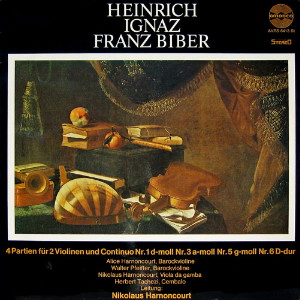 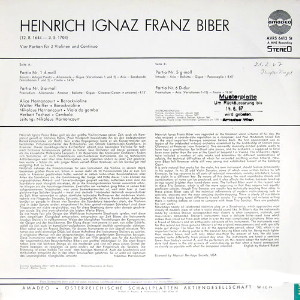 |
| - Amadeo - AVRS
6413 St - 1 LP - (p) 19?? |
|
|
|
Nikolaus
Harnoncourt (1929-2016)
|

|

|
|